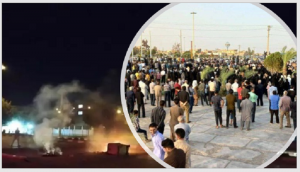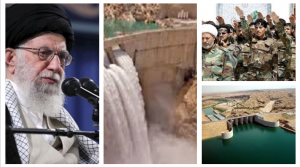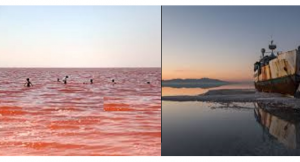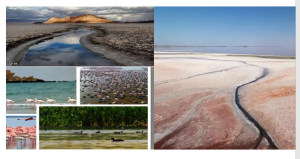(Video) Water shortages trigger protests in Iran

On Monday night, a large group of locals in Divandarreh, western Iran, held a protest rally as they are facing severe water shortages and the regime continues to ignore their needs. The people of the city have been facing three days of water outages.

The Iranian regime has continued to plunder the water rights of this lake despite these threats. According to the Sharif University of Tehran “The water level of Lake Urmia on June 3 was the lowest recorded since 1964, and in 2015 water volume decreased.”

The water rights determined by the environmental organization for this lake are 3 billion cubic meters per year.” Experts believe that one of the main reasons for the drying up of Lake Urmia is the construction of 57 dams in the northwest of Iran by the (IRGC).
The government officials hide the reality which results contradict the statements of the regime officials talking about the restoration of Lake Urmia.
Instead of addressing the people’s needs, the regime dispatched security forces to suppress the protests. The protesters resisted the repressive security forces and blocked roads with fire. Clashes between security forces and the people of Divandarreh continued late into the night. According to reports, security forces directly fired tear gas canisters into the crowd, injuring four civilians.
The protest comes as many regions of Iran are facing severe water shortages, mainly caused by the destructive policies of the ruling regime.
On Tuesday morning, the people of Zabol, Sistan and Baluchestan province, held a large rally, protesting water outages and poor air quality.
On July 22, Etemad newspaper reported that Lake Urmia, which was once known as the indigo eye of Iran, is in a more critical condition in comparison to previous years.
According to environmental experts, the water level of Lake Urmia has reached its lowest record in the last 60 years. The concern regarding the risk of Lake Urmia drying updates back to the beginning of the 2000s.
But the leaders of Iran’s regime have continued to plunder the water rights of this lake despite these threats. According to the results of a study by Sharif University of Technology, “The water level of Lake Urmia on June 3 was the lowest recorded since 1964, and now in 2015 the water volume has also substantially decreased.”
Attempts by government officials to hide the reality These results contradict the statements of the regime officials talking about the restoration of Lake Urmia.
Regime officials are trying to announce the improvement of Lake Urmia by presenting unknown and undated pictures and postponing its restoration to good rainfall in the new water cycle.
But it should be noted that reports on the level of Lake Urmia decreasing and reaching its lowest in the last 60 years are based on the data that the experts of the Lake Urmia research project gathered. The data provided by regime authorities cannot be relied on due to their history of hiding facts and doctoring reports in favor of the regime.
Potential to become an environmental bomb According to environmental experts, Lake Urmia has the potential to become an environmental bomb. The drying up of the lake can turn it into a source of dust in the northwest of the country.
Salt storms, which originate from Lake Urmia, could reach Karaj and Tehran. In the event of a storm spreading salt will cause a lot of financial damage to farms and gardens. Eventually, agriculture in the northwest of the country will face a serious threat.
Depriving water rights is the main reason for the drying of Lake Urmia The heads of the Iranian regime are trying to attribute the drying up of Lake Urmia to global climate change, claiming that the temperature increase of the earth by 2 degrees Celsius is the cause of the devasting condition of Lake Urmia.
In a conference in collaboration with the University of Berlin, regime officials mentioned this issue regarding the drying up of Urmia Lake. But an expert from the Geological Organization in an interview with state media reminded the rejection of this issue by German scientists and in the following said, “In this conference, one of the experts in the field of climate change objected to the report and announced: a temperature increase of 2 degrees Celsius is not scientific and if it were true, we ought to leave Germany. He suggested human factors involving this matter should be investigated.” (Source: Etemad newspaper, July 24) The noted human factor is the stealing of water rights for the past 20 years. The water rights of Urmia Lake are consumed for irrigating lands and gardens, whose main owners are the heads of the regime and commanders of the Revolutionary Guards.
The deputy of the regime’s environmental protection organization admits that less than 25% of the water rights allocated to Lake Urmia have flowed into it.
In an interview with the state-run Jahan-e Sanat on July 22, he said, “From the beginning of the current water year (from September 23, 2022, to mid-June 2023), from all the volume of water rights determined for Lake Urmia, only about 800 million cubic meters have been allocated to it. Therefore, the water rights determined by the environmental organization for this lake are 3 billion and 400 million cubic meters per year.” Experts believe that one of the main reasons for the drying up of Lake Urmia is the construction of 57 dams in the northwest of Iran by the Islamic Revolutionary Guards Corps (IRGC).
The construction of 82 dams in the catchment area of Anzali Lagoon is the reason the water level in this lagoon has decreased by one to two meters. Even though the IRGC has built the dams under the pretext of providing drinking water and agriculture for the people, these dams only provide about ten percent of the water consumed by agricultural lands.
Consequently, 40% of the country’s drinking water is wasted every year, and in the agricultural sector, we have 30% of water wasted every year, and the total of these two wastages is more than 40 billion cubic meters of water annually. This rate of water wastage is about one-third of the country’s water consumption.
The drying up of Lake Urmia is one of the hundreds of examples of the slaughtering of nature by the regime. This regime that has spent all the wealth of the country for its own survival, does not care about the improvement of the environmental situation.
For this reason, we are witnessing the destruction of many wetlands, rivers, etc. Zayandeh Rud, Gavkhoni, Maharlo, Karun, Horul Azim and… are just examples of this great crime by the current regime.
Shahin Gobadi
NCRI
+33 6 61 65 32 31
email us here
The drying up of Lake Urmia is one of the hundreds of examples of the slaughtering of nature by the mullahs regime in Iran.
Legal Disclaimer:
EIN Presswire provides this news content "as is" without warranty of any kind. We do not accept any responsibility or liability for the accuracy, content, images, videos, licenses, completeness, legality, or reliability of the information contained in this article. If you have any complaints or copyright issues related to this article, kindly contact the author above.


